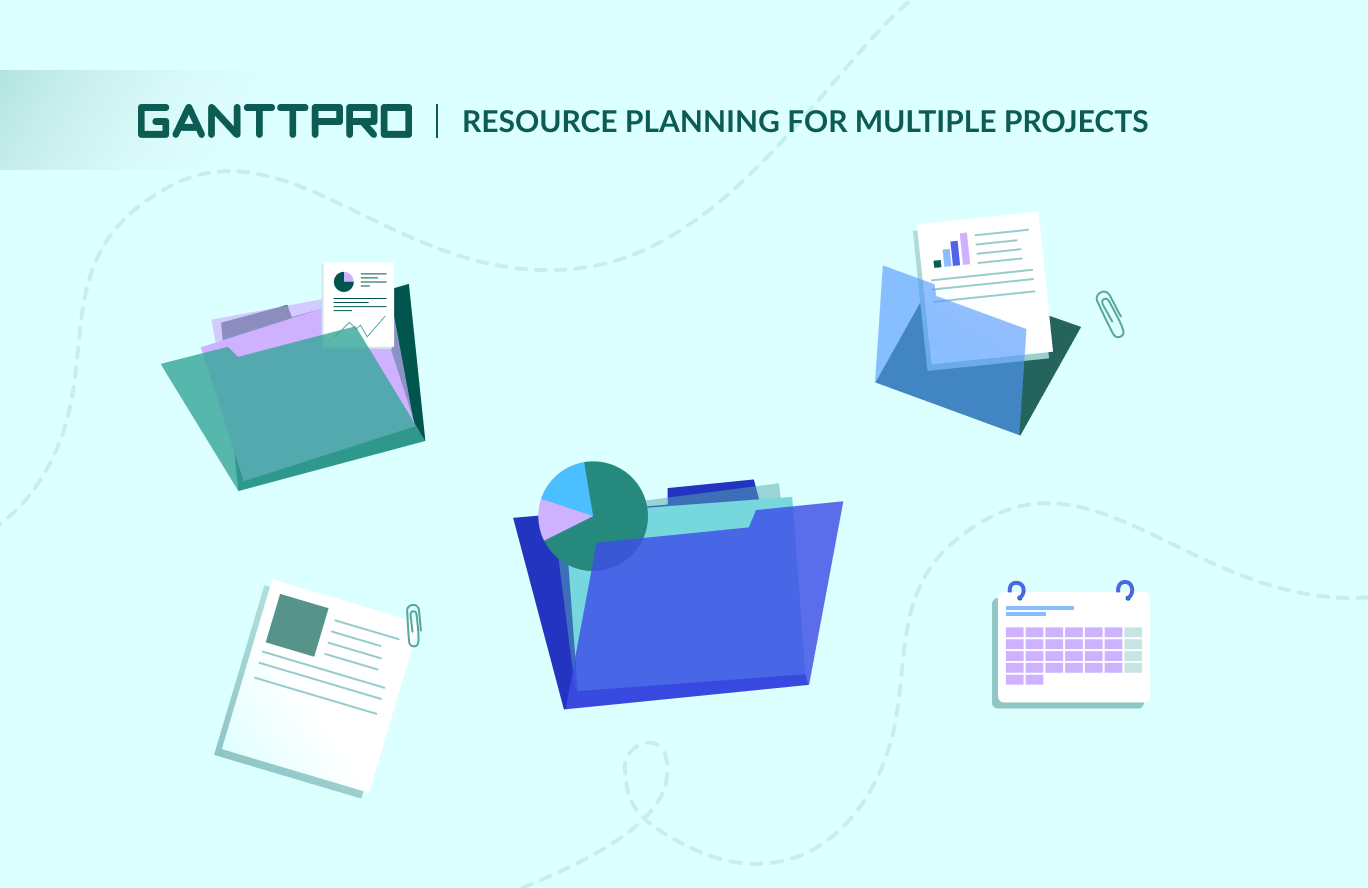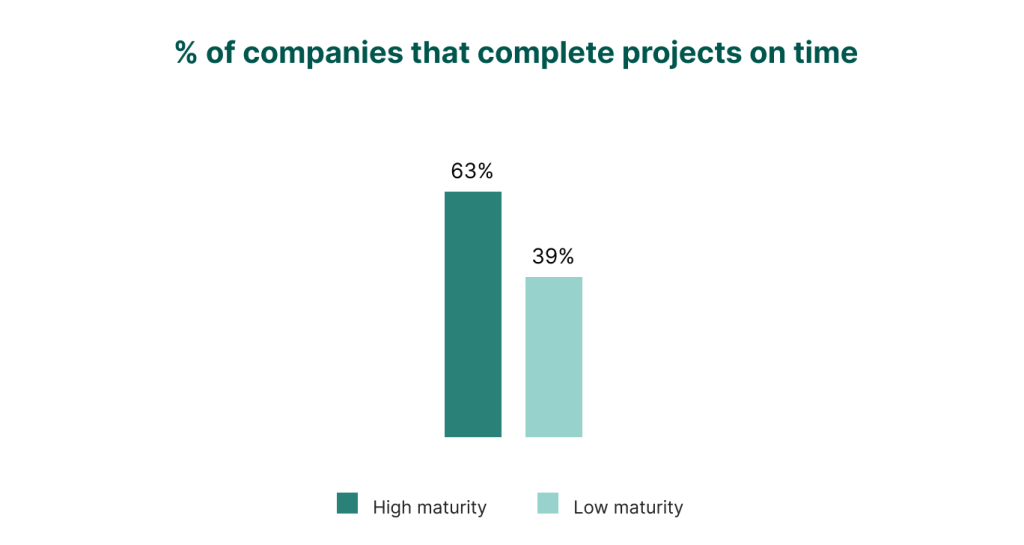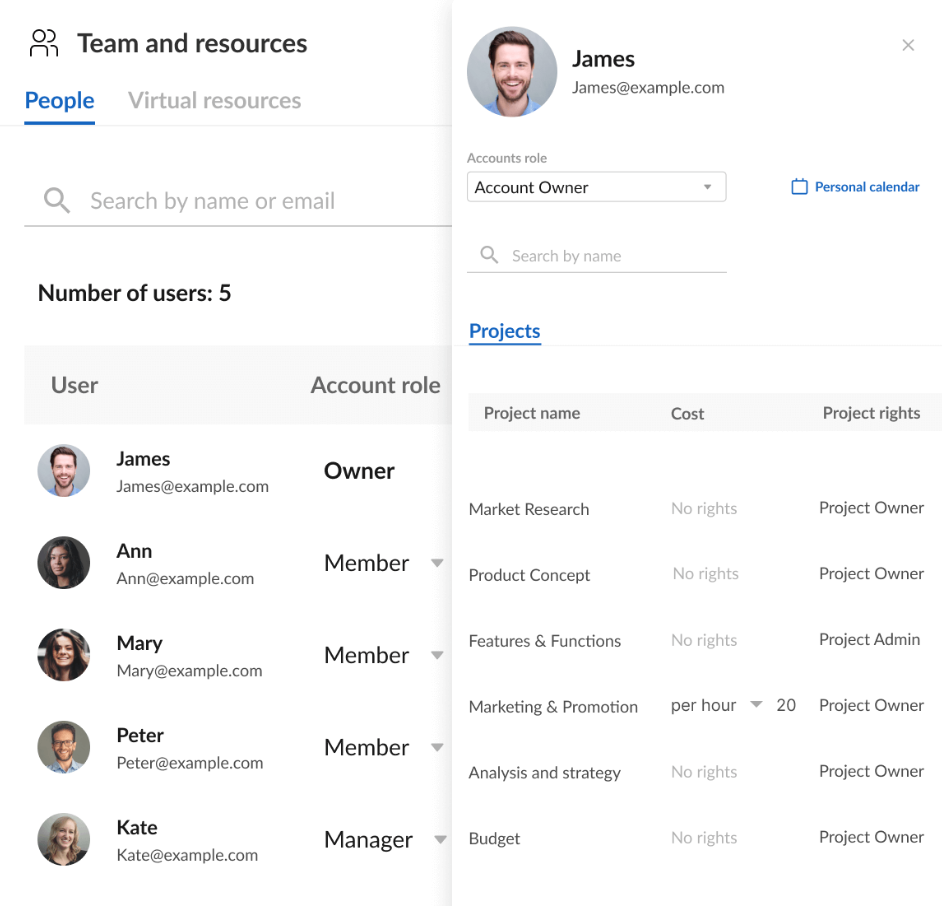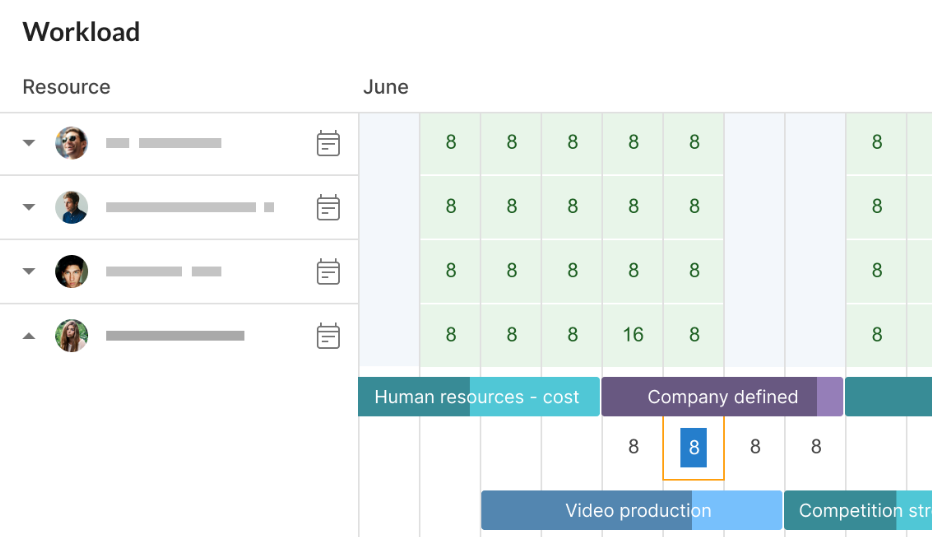How to Streamline Resource Planning for Multiple Projects: Strategic Approach for 2024

Audio version:
Resource planning for multiple projects may seem challenging and chaotic. Any business may face asset-related problems at any time. If teams don’t overcome resource constraints and threatening issues timely, they can derail their best-laid project plans.
However, by having a strategic resource management approach, forward-thinking project managers can improve their projects’ outcomes and overall productivity.
This article describes the process of professional resource planning for multiple projects and specific steps and tips for its improvement.
Contents:
- Challenges in resource planning for multiple projects.
- How to improve resource planning for multiple projects.
- Tips to empower the process of resource planning for multiple projects.
In simple words, resource planning for multiple projects is the process of organizing different projects that involve the same resources.
It’s expected that 88 million people around the world will work in project management by 2027. This evolving sphere requires managers and teams to become more qualified, skillful, and able to simultaneously control multiple projects and numerous tasks.
The topic of managing multiple projects at the same time is quite relevant and widely discussed in various spheres, from software development to manufacturing and construction. By the way, most project managers run between 2 and 5 projects.

This process of planning resources for multiple projects entails ranking tasks for all assets by importance and overseeing their advancement through predefined workflows. Responsible managers must guarantee that each project is adequately staffed and resources are not overallocated.
10 challenges in resource planning for multiple projects
Resource problems in a situation where you have to manage many projects are inevitable because you never know when and to what extent they may arise. Solving these issues can be extremely difficult, as each can have dozens of interconnected constraints.
However, by following reliable methods of resource allocation, suitable resource management techniques, and best practices as well as utilizing reliable online resource management tools you’ll be able to master professional asset planning and management.
Let’s explore some resource planning challenges in a multi-project background in more detail as you definitely should know them by sight.

1. Lack of required resources
The limitation of essential work assets relates to a significant obstacle in managing resources across several projects.
Organizations often face a limited pool of work assets that may cause conflicts between competing projects. To ensure that key projects receive the resources they need to advance without delay, it’s crucial to prioritize and allocate resources effectively.
Success in this area demands that managers focus on predicting resource needs, distributing assets according to project importance, and adapting allocations in response to evolving needs.
2. Manual data input
As any company grows, an increasing amount of employees’ time will be consumed by manual data entry or repetitive tasks. At this scale, manual duties become progressively error-prone.
Fortunately, modern PM platforms automate these tasks, diminishing the risks of errors and liberating staff from other repetitive responsibilities. The outcome is a more efficient and productive workforce.
3. Limited visibility
The lack of a complete project overview and professional visualization can result in making critical decisions without proper insight.
For example, project executives frequently require human resource planning for a robust commencement, followed by continuous monitoring for potential changes necessitating adjustments to reach project completion. However, relying solely on outdated spreadsheets for these tasks not only consumes productive hours but also involves planning resources without access to real-time data.
This limited visibility and inadequate resource allocation in project management may swiftly result in asset overutilization.
4. Deficient risk evaluation
Assessing business risks is a standard practice. However, if you need to organize multiple projects and numerous resources, you should pay special attention to all possible risks associated with them.
When composing a resource management plan, PMs must care about situations like illnesses, resignations, paid or unpaid leave, or any other factor that could disrupt workflows.
Just as mitigation strategies are prepared for various project risks, resource-related risks demand equal attention and planning.
5. Time management issues and conflicts
Coordinating schedules across numerous projects to avoid conflicts and ensure the availability of essential resources is also a significant challenge, even for experienced managers. This complexity increases due to varying project timelines, deadlines, and the need for certain resources to be shared across multiple projects at the same time.
According to PMI (the Project Management Institute), only 63% of mature companies and above 39% of young firms regularly complete projects on time.

6. Insufficient documentation
Inadequate documentation of resource usage significantly hampers resource planning for several projects. The absence of detailed and accurate records complicates the monitoring and allocation of work assets among different initiatives. This situation may result in inefficiencies, project delays, improper distribution of resources, and heightened project expenses.
7. Conflicting priorities among multiple projects
Managing several projects often demands identical competencies concurrently. This scenario can escalate competition, complicate resource allocation, and foster disagreements among managers, potentially resulting in conflicts.
Addressing this hurdle involves making impartial decisions that harmonize with strategic objectives while effectively managing stakeholder expectations. People responsible for resource planning must adeptly navigate changing priorities by establishing transparent communication channels and decision-making structures.
8. Poor communication
Weakly organized communication among employees and departments can also lead to certain resource planning problems. It typically results in resource misallocation and leads to late delivery of projects and unproductive work.
9. Weak forecasting and flexibility
Predicting the necessary resources for projects is inherently challenging due to the unpredictable nature of project scopes and timelines. This challenge increases when allocating resources among multiple projects, as unexpected changes in one project can impact the others.
The goal is to find the perfect balance between efficiently allocating resources and the flexibility needed to adapt to changes. It demands a robust resource planning system that can quickly adapt to variations.
10. Unresolved bottlenecks
Possible dependencies between multiple projects require careful attention. Even the smallest challenge arising in your workflow can grow like a rolling snowball and turn into a huge problem for the whole project.
If all roadblocks and bottlenecks aren’t noticed on time and resolved, they will negatively affect the other individuals’ work and other projects causing delays and financial exceeding.
Understanding all these challenges and possible scenarios for preventing them in your head will help you build the right resource management strategy, especially if you need to control several or many projects at the same time.
Now let’s move on to specific steps that will help you succeed in resource planning and management.
How to improve resource planning for multiple projects: 10 easy-to-follow steps
Effective resource management within different projects boosts efficiency, ensures timely project completion, and enhances team productivity. It involves detailed organization, planning, and the ability to handle competing resource requirements.
How to allocate resources if you are involved in managing several projects?
Let’s figure it out.
1. Clearly understand project requirements
Start by collecting the essential information about each project, including its scope, expected outcomes, deadlines, and specific resource needs.
This step will enable you to get a complete understanding of the necessities for each project. It will allow for the identification of necessary tools, materials, equipment, and other assets. Interaction with stakeholders and team members at this phase will offer important perspectives and assist in defining expectations.
2. Develop a flexible resource allocation strategy
Flexibility plays a crucial role in managing resources across multiple projects. Project managers need to devise or modify their strategy enabling the dynamic distribution of resources to address evolving project requirements. It may include the use of both permanent and temporary staff, along with reserve resources to handle unforeseen adjustments.
3. Apply resource planning software for better visualization
Leverage the advantages and features of modern PM tools to get a 360-degree visibility of all your resources and streamline all related processes.
Such platforms often help to allocate resources across projects, identify conflicts, and facilitate adjustments. They can assist in tracking project progress and allow for real-time resource reallocation as projects evolve.
There is no need to carry out long research and selection of such a solution because it is on the surface. GanttPRO, one of the best Gantt chart software, helps to centralize all your projects and resources in one place.

The platform comes with professional features that facilitate winning project outcomes in many fields, including software development, creative work, retail, manufacturing, construction, healthcare, and more. Its visually appealing Gantt chart with resource allocation offers complete visibility of all project assets and schedules.
Besides, PM professionals use GanttPRO to enhance task management, scheduling, deadline control, progress tracking, team collaboration, etc.
Project teams use GanttPRO for work planning, task organization, and resource allocation, acknowledging its reliability as resource management software.
Many PM newcomers and experienced managers admit the power of the Gantt chart maker for smooth and stress-free resource planning, tracking, and coordinating.
For example, George Rossle, a production manager at A+ Construction Pro, shares his thoughts as follows:
For us, GanttPRO is a basic tool for planning and management. We use the software for deadline management and time tracking, file sharing, and smart scheduling.
Before planning and organizing resources, GanttPRO will help you divide all the activities within your multiple projects into separate tasks and subtasks, using a work breakdown structure (WBS). You’ll be able to define milestones and visualize task dependencies on a Gantt chart.
After a timeline organization, you can invite team members, specify their roles, and set costs and calendars for them. Creating virtual resources (people, materials, tools, equipment, etc.) is also possible there.

4. Distribute resources accordingly
Proper resource allocation means that no resource is under or overutilized against its capacity.
With the help of such smart solutions as GanttPRO, project managers can easily assign workers or resources to tasks. A Gantt diagram ensures that all assets are distributed appropriately based on their availability and initial characteristics. You can allocate one resource or several resources to each task.

Online resource management software
Plan project resources, control workloads, and collaborate with teammates with ease.
Sign up for free5. Enhance workload management
When employees have to manage multiple projects simultaneously, they quickly become overworked and stressed. It may lead to decreased productivity as well as cause missed deadlines and reduced performance quality.
Clear workload management allows for better resource scheduling and work control. This is a field where GanttPRO is also a reliable helper. Being recognized among the top workload management tools, it boosts task tracking and enables proper resource allocation adjustments to prevent possible underutilization or overloading.

GanttPRO users can see their workloads right under a project timeline. They can manage resources in a separate window for one project or the same window but for all projects.
Here’s what Łukasz Wielądek, a project manager at GonnaBe, an advertising agency, says about the feature of workload management in GanttPRO:
When I have to plan work for a team for the whole week, it’s really easy with GanttPRO. Resource workload is a nice feature because you can see how many hours a person has and adjust the workload to these hours.
6. Conduct a regular resource inventory
Take time to keep a record of all available project management resources, including tools, personnel, equipment, and materials. Assess their availability and capacity. Such a comprehensive inventory will serve as a foundation for effective resource allocation.
Consider not only the current availability but also potential future changes in asset availability due to other commitments or external factors.
7. Estimate costs
Managers who deal with resource planning should remember the importance of budget management and correct cost estimation.
In GanttPRO, they can schedule their financial strategies and track project expenses in real time. They can determine costs for all resources per hour, per item, or just cost.
8. Prioritize projects and tasks
There are no similar projects. Some of them can be more critical to the company’s strategic objectives or more urgent in terms of deadlines. By prioritizing projects and certain tasks, project managers can ensure that the most crucial work is done first and resources are allocated accordingly.
It usually requires collaboration with top managers to align project priorities with business goals.
9. Track and adjust resource allocation
If you think that resource planning for multiple projects is a one-time task, then you’re wrong as it’s surely about an ongoing process.
It’s better to regularly review project progress and resource utilization to determine possible discrepancies between planned and actual asset use. You should be ready to adjust asset allocation as needed to address unexpected challenges, project delays, or shifts in project scope.
10. Improve communication
Effective communication is crucial for managing resources across various projects. Project managers need to promote open conversations among team members to enhance their connections, exchange ideas, and address challenges in resource distribution. Such a strategy promotes a supportive and adaptable work environment.
It’s worth noting that GanttPRO facilitates team collaboration allowing individuals to share documents, get notifications, attach files, and easily communicate at any time.
Following the steps mentioned above will lead you to better resource planning, even if you have multiple projects to work with. However, for a better understanding of the subject, you’d better take into account some essential recommendations.
10 tips to empower the process of resource planning for multiple projects
There are some helpful strategies and recommendations that will help you enhance efficiency, visibility, and collaboration across teams and projects.
Below are some areas for improvement and some essential tips you may follow right away.
1. Centralize resource management
Explore different resource scheduling tools and choose a comprehensive system to gain visibility into your resources’ availability and workload across all projects. It will aid in informed decision-making regarding asset distribution and anticipating future requirements.
2. Provide flexible resource pooling
Use a flexible approach to resource allocation which will mean that your resources can be shared and moved between different projects as needed. It will regulate asset utilization and minimize downtime or bottlenecks caused by resource constraints.
3. Prioritize projects timely
Project managers should clearly define and prioritize project tasks based on revenue potential, strategic importance, or other criteria. It will ensure that critical activities have the necessary resources and are aligned with business goals.
4. Improve skills
Try to regularly motivate each team member to improve and develop their skills, experience, and interests. It will ensure optimal matching of project requirements with the right resources and enhance both project success and employee satisfaction.
5. Streamline collaboration
Promote transparent communication across all project members and stakeholders. Conduct frequent meetings to keep everyone informed about project progress, resource allocation, and upcoming obstacles.
6. Invest in training
Invest in team development and relevant training programs to broaden your workers’ skill set. It will make your team capable of working with multiple projects and filling gaps during peak demand without the need for extra hiring.
7. Prepare a contingency plan
Having a contingency plan for resource management is a fabulous idea. Unexpected changes in timelines, project scope, or resource availability may occur at any time. They can impact multiple projects, so it’s vital to have backup plans and flexible resources.
8. Review projects
Continuously review and optimize your resource planning processes. Keep in mind the lessons learned from past projects to improve resource allocation, forecasting accuracy, and project outcomes.
9. Forecast regularly
Remember to regularly forecast resource needs based on ongoing work processes. Anticipate periods of high demand and schedule accordingly to avoid burnout or overallocation.
10. Use real-time reports
Use analytics on resource utilization and real-time reporting. They will help you make quick adjustments if needed and ensure informed decision-making.
Turn routine planning for multiple projects into a high-performance process
Resource planning for multiple projects is not an incomprehensible science. To succeed, you need to improve your skills as well as follow all the steps and tips described above.
Before generating a detailed plan, consider your project scope, personnel, financials, and other essential aspects. Take your time and carefully select a powerful resource management tool customized to your business requirements.
Tools like GanttPRO offer a comprehensive overview of your project resources, ensuring clear communication and understanding of various projects within your team. This approach supports informed decision-making, improves business processes, and optimizes resource allocation.


